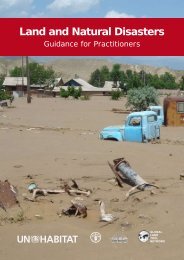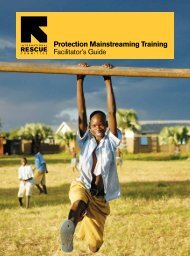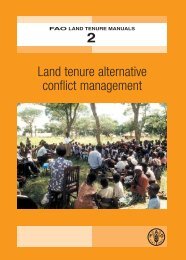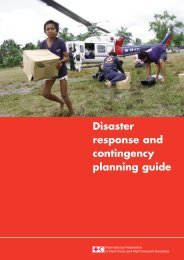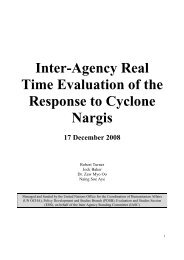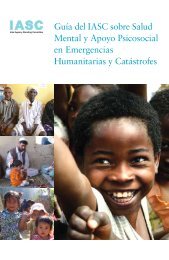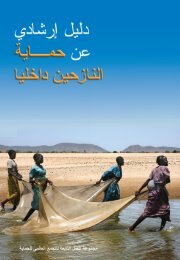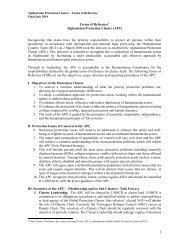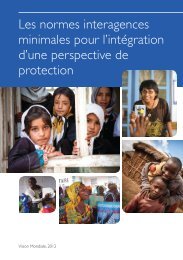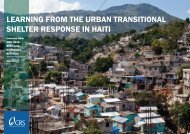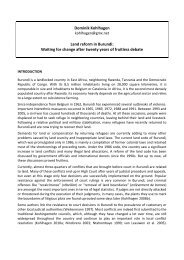Mid-Year Review of the Work Plan for Sudan 2012 - Global ...
Mid-Year Review of the Work Plan for Sudan 2012 - Global ...
Mid-Year Review of the Work Plan for Sudan 2012 - Global ...
Create successful ePaper yourself
Turn your PDF publications into a flip-book with our unique Google optimized e-Paper software.
UNITED NATIONS AND PARTNERS[2] PROGRESS | SECTOR RESPONSEMID YEAR REVIEW | SUDAN WORK PLAN <strong>2012</strong>27TABLE OF MID-YEAR MONITORING VS. OBJECTIVESOutcomes (withcorresponding targets)Outputs (with corresponding targets)Indicators (with correspondingtargets and baseline)Achieved as mid-yearStatusObjective 1: Improve <strong>the</strong> overall operating environment <strong>for</strong> humanitarian through advocacy and streng<strong>the</strong>ned coordination.1. Streng<strong>the</strong>ned coordinationmechanisms, responses andpreparedness <strong>for</strong> humanitarianand recovery action.2. Streng<strong>the</strong>ned in<strong>for</strong>mationmanagement.1. Regular interactions amongst actors withstrong engagement on humanitarian and recoveryissues. (Government, UN, NGOs, donors,Red Crescent etc.).2. Increased data and in<strong>for</strong>mation collection anddissemination, including SADD3. Supporting <strong>the</strong> development <strong>of</strong> common policiesand positions regarding durable solutions(in conjunction with return and reintegrationsector), improving <strong>the</strong> quality <strong>of</strong> needs assessments,gender mainstreaming and rein<strong>for</strong>cingcoordination mechanisms.75% <strong>of</strong> functional coordinationmechanisms in place: HumanitarianCoordniation Team (HCT), Inter-Sector Coordinators Group (ISCG),Joint Verification Mechanism (JVM).75% <strong>of</strong> in<strong>for</strong>mation managementproducts timely produced anddisseminated (reports, maps, andminutes).11 HCT, three ad hocHCT, and five ISCGmeetings.15 logistics support mapsproduced 12 communityleaders meetings and168 community committeesmeetings in Zamzamcamp.On TrackObjective 2: Improve <strong>the</strong> efficiency <strong>of</strong> humanitarian programmes by providing common services that reduce indirect costs through economies <strong>of</strong> scale, increasedaccess to humanitarian pooled funding, common transport services, expansion <strong>of</strong> mapping services and provision <strong>of</strong> security support and advice.1. Increased rate <strong>of</strong> utilization<strong>of</strong> common services <strong>for</strong>humanitarian action.1. Safe and efficient air transport provided thatimprove access to and delivery <strong>of</strong> assistance toaffected population.2. Increased access to security services andsupport.3. Timely allocations made to <strong>the</strong> most urgentneeds and critical gaps.Number <strong>of</strong> passengers, agencies,tonnage <strong>of</strong> cargo transported, anddestinations reached.100 % coverage <strong>for</strong> security training,assessments, evacuations,reports, and maps meeting userrequirements.Security communicationsservices: very high frequency /high frequency (VHF/HF) radiobackbone, 24/7 operational radiochecks, technical support) insupport <strong>of</strong> staff safety and security,provided in all 15 approved interagencylocations.Total cargo transported56,821 Kg.Total passengers transported7,1801200 students beenrelocated to El Fasher tosit <strong>for</strong> basic educationexamination fromZamzam IDPs camp.Dissemination <strong>of</strong> SituationReports – daily, 100%coverage.One week security training<strong>for</strong> INGO in deepfield (in situ).One relocation <strong>for</strong> INGOstaff.SevenMORSS/MOSSassessments and ninesecurity assessmentmissions.On TrackObjective 3: Build capacity <strong>of</strong> national and international actors to respond effectively and efficiently to existing and un<strong>for</strong>eseen humanitarian needs.1. Enhanced local partners’capacities to lead humanitarianand recovery responses1. Improved partnership and coordinationamongst and with national partners.2. Increased number <strong>of</strong> Government andnational actors involved in humanitarian work.Number <strong>of</strong> training conductedand people trained disaggregatedby sex.Number <strong>of</strong> local partners involvedin humanitarian and recoveryactivities.<strong>Global</strong> PositioningSystem (GPS) training<strong>for</strong> 22 national NGO’smembers in Darfur Statesand Khartoum.185 teachers beentrained from <strong>the</strong> ministry<strong>of</strong> education in teachingskills.On TrackImplementation ChallengesThe two major challenges encountered by <strong>the</strong> sector arehumanitarian access and funding constraints. Partners facedrestrictions on access to affected areas and beneficiaries inSouth Kord<strong>of</strong>an, Blue Nile and in some parts <strong>of</strong> Darfur, particularly<strong>the</strong> areas under <strong>the</strong> control <strong>of</strong> armed opposition movements.Limited funding has greatly affected sector partners’operations and activities, affecting progress towards <strong>the</strong> <strong>2012</strong>HWP targets and objectives. UNHAS’s financial situation maybecome critical by <strong>the</strong> end <strong>of</strong> June as <strong>the</strong>y will have used allreceived funding and may be <strong>for</strong>ced to scale back operations,which would affect many humanitarian organizations. TheGovernment imposed additional bureaucratic procedures onUNHAS which has increased <strong>the</strong> already extensive proceduresthat were in place. In terms <strong>of</strong> funding, delays in donor dispersal<strong>of</strong> CHF funding have held back activities <strong>of</strong> most partners,including <strong>the</strong> recruitment <strong>of</strong> a UNDSS INGO Liaison Officer <strong>for</strong>North Darfur.Changes in TargetsNo changes in targets reported.Sector Project RevalidationSector coordination meetings, including national partners,were held to exchange in<strong>for</strong>mation to avoid any duplicationand ensure coverage to <strong>the</strong> extent possible. Fur<strong>the</strong>r, projectshave been re-prioritized with only 38% <strong>of</strong> projects ranked ashigh priority to ensure funding <strong>for</strong> <strong>the</strong> highest priority activities.



